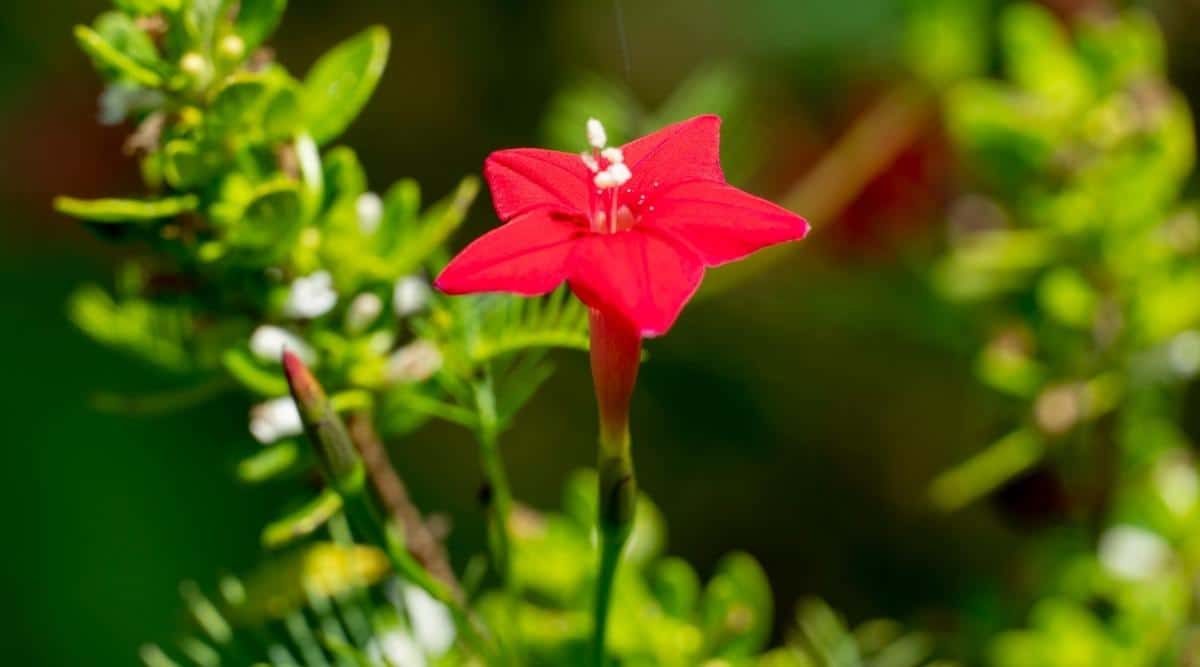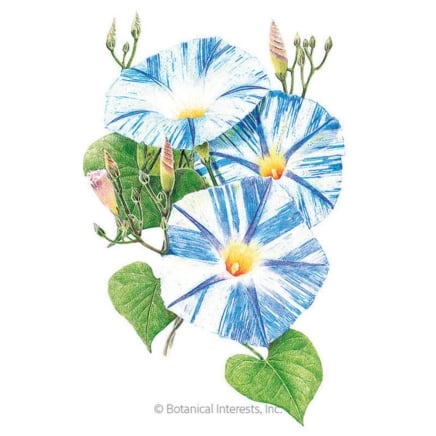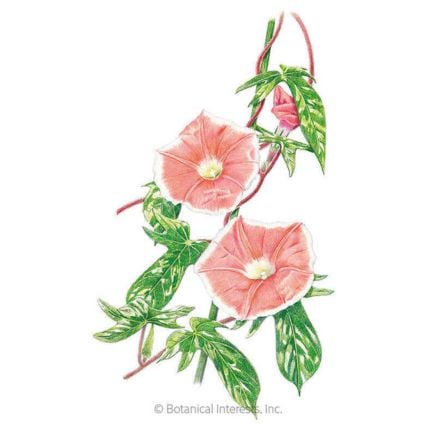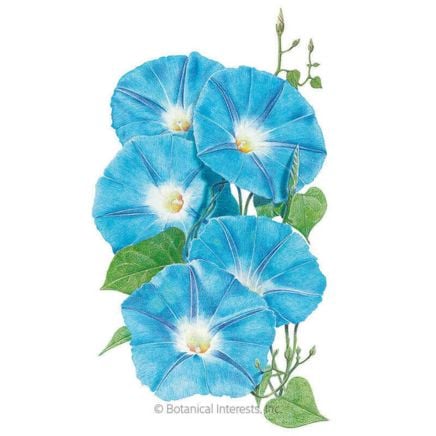Morning Glory Varieties: 17 Types of Morning Glories
Thinking of planting some morning glories to your garden, but aren't sure which type to choose? There are a number of different morning glory varieties that grow quite quickly in most gardens. In this article, we take a look at our favorite types of morning glory vines to plant in your home garden.

Contents
Did you know there are more than 1,000 different morning glory varieties? That’s a whole lot of morning glories that you can add to your garden! But that also means it’s probably confusing when you are trying to pick one of these popular flowering vines to plant.
Although all morning glories come from the Ipomoea genus, most of those 1,000+ varieties are cultivars of the nil, purpurea, or tricolor species. But, because there are so many different types of morning glory, it can get a bit overwhelming. The good news is that this gives you more options to choose from in order to find the perfect plant for your garden.
So, out of all of these beautiful vines, which type of morning glory is the best fit for your garden? Continue reading, as this article covers 17 types of our favorite morning glory varieties that will look great in any garden!
Beach Morning Glory

|
|
botanical name Ipomoea pes-caprae |
|---|---|
|
|
plant type Perennial |
|
|
sun requirements Full sun |
|
|
height 7-11 feet |
|
|
hardiness zones 9-11 |
The beach morning glory is a common perennial creeping vine found on the upper parts of beaches. It’s a strong sand stabilizer that thrives in salty conditions. You can identify it by its broad evergreen leaves and light purplish-pink flowers.
You can find this variety most commonly on the shores of the Atlantic, Pacific, and Indian oceans. However, it’s an excellent choice for a garden due to its hardiness.
This variety has a strong root system and grows in mats, making it an excellent choice for groundcover. It does well in most conditions, although it’s particularly hardy in hot, salty, or windy conditions. Once established, they require little more than basic maintenance.
Black Kniolas

|
|
botanical name Ipomoea purpurea |
|---|---|
|
|
plant type Annual |
|
|
sun requirements Full sun |
|
|
height 7-11 feet |
|
|
hardiness zones 2-11 |
Although not a true black, the black kniolas flowers in a deep purple that’s the darkest shade you’ll find. These pretty flowers have a pink center that fades into the purple petals, forming dark red stripes on the bloom itself.
A half-hardy annual, this climber is easy to grow. It’s the perfect choice if you want a great color contrast with your other flowers. It can grow up to 8 feet tall, so it’s not quite as large as different varieties.
In temperate zones, these morning glory varieties bloom all summer long. They also do really well in containers, so you can bring yours inside when it gets cold to keep it growing throughout the year.
Chocolate

|
|
botanical name Ipomoea nil |
|---|---|
|
|
plant type Annual |
|
|
sun requirements Full sun |
|
|
height 6-15 feet |
|
|
hardiness zones 2-12 |
The chocolate variety is one of the more subdued morning glories. Its mauve flowers and tri-lobe leaves aren’t as showy as some of the others, but the white picotee edge and 5-6 inch blooms still make it a great addition to a garden.
This twining annual is a rare variety, so you won’t see it too often. It’s also easy to grow and can reach heights of 14 feet. However, it’s not terribly prolific, so this is a good option if you want to avoid bringing in an invasive plant.
Common Morning Glory

|
|
botanical name Ipomoea purpurea |
|---|---|
|
|
plant type Annual |
|
|
sun requirements Full sun |
|
|
height 6-10 feet |
|
|
hardiness zones 2-11 |
The common morning glory is a vining purple flower native to Mexico and Central America. It thrives in the moist, rich soil of tropical regions, and has petals that are usually a gradient of purple, blue, and white. The leaves are heart-shaped, and you’ll find tiny hairs on the stems.
This variety can reach heights ranging from 6-9 feet. It also works well as ground cover as long as it’s well-maintained. Medium-sized 3-inch blooms appear in midsummer and will continue to bloom into the fall.
This variety is a fast-growing plant, so it’s important to consider growth control when planting. Be sure to use a trellis to keep the plant from taking over your space.
Crimson Rambler

|
|
botanical name Ipomoea purpurea |
|---|---|
|
|
plant type Annual |
|
|
sun requirements Full sun |
|
|
height 6-10 feet |
|
|
hardiness zones 2-11 |
The crimson rambler is a cultivar of the common morning glory that’s a bit more versatile. As a durable twining vine, this variety is ideal for covering things like fences, archways, or unsightly and immovable yard fixtures.
This dark pink flower is touched with red stripes and a white center. It thrives best in warm, humid conditions and well-drained soil. When maintained properly, you can get vines reaching up to ten feet long filled with 2-3 inch blooms.
The crimson rambler is a vining perennial in tropical climates and an annual in non-tropical climates. And, like other varieties of purpurea, the crimson rambler is somewhat toxic.
Cypress Vine

|
|
botanical name Ipomoea quamoclit |
|---|---|
|
|
plant type Annual |
|
|
sun requirements Full sun |
|
|
height 6-15 feet |
|
|
hardiness zones 11-12 |
Another lovely variety is the cypress vine. Although it’s a tropical native, it’s distributed globally. This variety thrives in most places, although it’s considered invasive in warmer climates.
The cypress vine is an ornamental that boasts small red flowers, lacy leaves, and can climb anywhere from 3 to 10 feet tall. If you choose to grow it outside, you’ll need to replant it annually. However, if you plant it in a container and bring it indoors in the colder months, you’ll have blooms all year round.
Hummingbirds and pollinators are especially attracted to the cypress vine. So, if you’re hoping to attract some colorful guests to your garden, you’re in luck.
Flying Saucers

|
|
botanical name Ipomoea tricolor |
|---|---|
|
|
plant type Annual |
|
|
sun requirements Full sun |
|
|
height 8-10 feet |
|
|
hardiness zones 2-12 |
The flying saucer will be perfect if you want a stand-out morning glory with large blooms. This pretty flower has 5-inch periwinkle blossoms striped with white and a yellow throat that perfectly contrasts the blue.
The flying saucer has heart-shaped leaves and can twine up to 10 feet on a trellis or in a container. As annual morning glory varieties, you’ll want to plant in spring after the final frost. Then, you’ll get flowers starting in mid-summer.
In addition to being an attractant for pollinators, the flying saucer is also a good deer repellent. So, if you’re tired of chasing deer away from your flowers, consider planting these in your garden.
Heavenly Blue

|
|
botanical name Ipomoea tricolor |
|---|---|
|
|
plant type Annual |
|
|
sun requirements Full sun |
|
|
height 8-10 feet |
|
|
hardiness zones 2-12 |
The Heavenly Blue morning glory variety looks just as it sounds. This annual climber is a vivid sky blue with a white and yellow throat. The blooms grow from 3-to-5 inches across, and the leaves are a lovely heart shape.
This fast-growing, self-seeding variety blooms from early summer into fall in temperate zones. As a native of Central America, it thrives best in warmer climates. However, in a yard with full sun, you can get a plant that grows up to 10 feet.
These are deer-resistant morning glory varieties. It has the added benefit of being pest and disease-resistant, too, making it a good choice if you want something low-maintenance.
Japanese Morning Glory

|
|
botanical name Ipomoea nil |
|---|---|
|
|
plant type Annual |
|
|
sun requirements Full sun |
|
|
height 6-15 feet |
|
|
hardiness zones 2-12 |
Contrary to its name, the Japanese morning glory is native to the American tropics. It comes in various colors, but its most common hues are bright blue or reddish-purple. Some will even come out with pretty white stripes on their petals.
This ornamental climber doesn’t handle frost well, so if you’re in a temperate zone, you’ll want to bring your Japanese morning glories inside come winter. It’s self-seeding, though, so you won’t have to worry about replanting if you’re in a warm area.
However, just keep in mind that this is a larger plant. It can grow up to 16 feet tall and cover broad areas. Between its height and 5-inch flowers, this one really stands out.
Mexican Morning Glory

|
|
botanical name Ipomoea tricolor |
|---|---|
|
|
plant type Annual |
|
|
sun requirements Full sun |
|
|
height 8-10 feet |
|
|
hardiness zones 2-12 |
This variety is an ornamental climber that can grow up to 13 feet tall. Its white-throated blooms boast shades of blue and purple, and it has broad leaves, making it an excellent coverage plant.
You can grow this variety as a perennial in the tropics. However, since it doesn’t tolerate temperatures under 4°F, you’ll need to replant it annually in temperate zones.
You’ll want to plant this variety after the final frost in mid-to-late spring. It grows well on walls, in containers, or along trellises. As a sun-loving plant, you should put it in an area with plenty of sunlight.
Milky Way

|
|
botanical name Ipomoea tricolor |
|---|---|
|
|
plant type Annual |
|
|
sun requirements Full sun |
|
|
height 8-10 feet |
|
|
hardiness zones 2-12 |
The Milky Way variety gets its name from the white star shape in the center of its blue or purple petals. It’s an annual climber that provides blooms 3-4 inches wide with broad, spade-shaped leaves.
This plant can grow from 7 to 13 feet long, so it’s ideal for ground coverage. However, it’s considered invasive in some states, so it might be tough to find. Once it’s taken hold, it’s also very difficult to remove, so proceed with caution.
It flourishes best in the summer and temperatures above 70°F, so whether it’s an annual or perennial will depend on your climate. That said, if you choose to grow this one, you’ll need to do proper pruning to keep it under control.
Mini-bar Rose

|
|
botanical name Ipomoea nil |
|---|---|
|
|
plant type Annual |
|
|
sun requirements Full sun |
|
|
height 6-15 feet |
|
|
hardiness zones 2-12 |
A cultivar of the Japanese morning glory, the mini-bar rose is a smaller variety. It has bright pink petals with a white throat and accents, and green and white tri-point leaves. The small flowers and ivy-like leaves give it a delicate appearance.
This low-maintenance summer bloomer is ideal for hanging baskets or pots because it only grows to about 5 feet tall. Its size also makes it perfect for indoor growing. If you bring your flowering plants in at the end of the growing season, you’ll be able to keep this one growing all year.
Moonflower

|
|
botanical name Ipomoea alba |
|---|---|
|
|
plant type Perennial |
|
|
sun requirements Full sun |
|
|
height 10-15 feet |
|
|
hardiness zones 9-12 |
If you want a flower you can enjoy in the evening, the moonflower is the only morning glory species to flower only at night. Its white blooms are huge, spanning 7 inches across, and they stay open through the night and often during the day if it’s overcast or cool.
Since this variety is native to the tropics, it thrives in 70-75°F temperatures. In areas where it’s native, it’ll grow as a perennial. In northern, more temperate climates, you’ll be able to grow it as an annual.
Rivea corymbosa

|
|
botanical name Ipomoea corymbosa |
|---|---|
|
|
plant type Perennial Annual |
|
|
sun requirements Full sun |
|
|
height 15-20 feet |
|
|
hardiness zones 11 |
Rivea corymbosa is a perennial creeping vine native throughout Latin America. It’s a highly fragrant ornamental with yellow-throated white flowers and spade-shaped leaves. This variety is the most unique on this list.
The river corymbosa is the main honey plant in Cuba. Its nectar makes it very attractive to bees and hummingbirds. However, this might not be the best choice if you want to avoid attracting too many pollinators.
Keep in mind that this plant is invasive to the US, Spain, and Australia. However, it’s naturalized in many areas, including the Southern US. The seeds are quite poisonous, and they can grow to cover an area more than 30 feet long. Keep that in mind when you’re considering maintenance.
Scarlett O’Hara

|
|
botanical name Ipomoea tricolor |
|---|---|
|
|
plant type Annual |
|
|
sun requirements Full sun |
|
|
height 8-10 feet |
|
|
hardiness zones 2-12 |
Named for the famous Gone With the Wind character, the Scarlett O’Hara morning glory is a showy, vibrant flower. It has pink and red blooms with white throats and pretty heart-shaped leaves.
This annual variety grows up to 10 feet tall and offers 3-4 inch blooms all summer long. It does best in moist, well-drained soil and full sun. Fortunately, it doesn’t require much maintenance, making it easy to grow.
Tie-Dye

|
|
botanical name Ipomoea nil |
|---|---|
|
|
plant type Annual |
|
|
sun requirements Full sun |
|
|
height 6-15 feet |
|
|
hardiness zones 2-12 |
If you want a flower that truly stands out, the tie-dye variety is it. Its splashy blue, purple, and pink shades have a watercolor appearance reminiscent of tie-dye t-shirts.
It’s an annual vine that blooms in the late spring to early fall, depending on your region. It’s pretty prolific, so you’ll get a lot of blooms on 8 to 10-foot vines. This variety is a climber, so have a trellis or other growing guide on hand. Aside from that, they’re simple to maintain and look great.
Wedding Bell

|
|
botanical name Ipomoea tricolor |
|---|---|
|
|
plant type Annual |
|
|
sun requirements Full sun |
|
|
height 8-10 feet |
|
|
hardiness zones 2-12 |
A cultivar of the Heavenly Blue, the Wedding Bell offers vibrant lavender blooms touched with yellow in the center. It has smooth, hairless vines, heart-shaped leaves, and mid-sized 3 to 4-inch blossoms.
The Wedding Bell adapts to its environment, doing well in both sun and shade. It nearly went extinct in the early 2000s, but die-hard fans brought it back from the brink.
The most important thing to remember about Wedding Bells is that it’s temperamental regarding pollination. If a Wedding Bell gets cross-pollinated with another variety, mainly the Heavenly Blue, it’ll revert to a standard blue.












